Multidisciplinary Applications of AI in Dentistry: Bibliometric Review
Abstract
:1. Introduction
2. Materials and Methods
2.1. Data Collection
2.2. Methodology
3. Results
3.1. The Scientific Discourse
3.1.1. The Development of the Field
3.1.2. Publications Outlets
3.1.3. Producers’ Locations
3.2. Thematic Focus
3.2.1. Extraction from Keywords
3.2.2. Extraction from Abstracts
3.3. The Evolving Discussion
3.3.1. Longitudinal Development of Keywords
3.3.2. Trending Topics in the Abstracts
3.3.3. Most Relevant Discussion
4. Discussion
5. Conclusions
Author Contributions
Funding
Institutional Review Board Statement
Informed Consent Statement
Data Availability Statement
Conflicts of Interest
References
- Davenport, T.; Kalakota, R. The potential for artificial intelligence in healthcare. Future Healthc. J. 2019, 6, 94–102. [Google Scholar] [CrossRef] [PubMed]
- Shan, T.; Tay, F.R.; Gu, L. Application of Artificial Intelligence in Dentistry. J. Dent. Res. 2021, 100, 232–244. [Google Scholar] [CrossRef] [PubMed]
- DaSilva, A.F.; Robinson, M.A.; Shi, W.; McCauley, L.K. The Forefront of Dentistry—Promising Tech-Innovations and New Treatments. JDR Clin. Transl. Res. 2022, 7, 16S–24S. [Google Scholar] [CrossRef] [PubMed]
- Oh, S.L.; Jones, D.; Kim, J.R.; Choi, S.K.; Chung, M.K. Comparison Study of Diagnosis and Treatment Planning for Dental Infections between Dental Students and Practitioners. Healthcare 2022, 10, 1393. [Google Scholar] [CrossRef]
- Hung, K.F.; Ai, Q.Y.H.; Leung, Y.Y.; Yeung, A.W.K. Potential and impact of artificial intelligence algorithms in dento-maxillofacial radiology. Clin. Oral Investig. 2022, 26, 5535–5555. [Google Scholar] [CrossRef]
- Issa, J.; Jaber, M.; Rifai, I.; Mozdziak, P.; Kempisty, B.; Dyszkiewicz-Konwińska, M. Diagnostic Test Accuracy of Artificial Intelligence in Detecting Periapical Periodontitis on Two-Dimensional Radiographs: A Retrospective Study and Literature Review. Medicina 2023, 59, 768. [Google Scholar] [CrossRef]
- Xie, B.; Xu, D.; Zou, X.Q.; Lu, M.J.; Peng, X.L.; Wen, X.J. Artificial intelligence in dentistry: A bibliometric analysis from 2000 to 2023. J. Dent. Sci. 2024, 19, 1722–1733. [Google Scholar] [CrossRef] [PubMed]
- Thelwall, M.; Sud, P. Scopus 1900–2020: Growth in articles, abstracts, countries, fields, and journals. Quant. Sci. Stud. 2022, 3, 37–50. [Google Scholar] [CrossRef]
- Borgohain, D.J. Analysis Based on Scopus Database Analysis Based on Scopus Database Research Output of Dibrugarh University: A Scientometric Analysis Based on Scopus Database. 2020. [Online]. Available online: https://digitalcommons.unl.edu/libphilprac (accessed on 12 March 2024).
- Baas, J.; Schotten, M.; Plume, A.; Côté, G.; Karimi, R. Scopus as a curated, high-quality bibliometric data source for academic research in quantitative science studies. Quant. Sci. Stud. 2020, 1, 377–386. [Google Scholar] [CrossRef]
- Ninkov, A.; Frank, J.R.; Maggio, L.A. Bibliometrics: Methods for studying academic publishing. Perspect. Med. Educ. 2022, 11, 173–176. [Google Scholar] [CrossRef]
- Chen, Y.; Yeung, A.W.K.; Pow, E.H.N.; Tsoi, J.K.H. Current status and research trends of lithium disilicate in dentistry: A bibliometric analysis. J. Prosthet. Dent. 2021, 126, 512–522. [Google Scholar] [CrossRef] [PubMed]
- Qasim, S.S.B.; Ali, D.; Khan, A.S.; Rehman, S.U.; Iqbal, A.; Baskaradoss, J.K. Evidence-Based Bibliometric Analysis of Research on Silver Diamine Fluoride Use in Dentistry. BioMed Res. Int. 2021, 2021, 9917408. [Google Scholar] [CrossRef]
- Chen, M.-C.; Chen, S.-H.; Cheng, C.-D.; Chung, C.-H.; Mau, L.-P.; Sung, C.-E.; Weng, P.-W.; Tsai, Y.-W.C.; Shieh, Y.-S.; Huang, R.-Y.; et al. Mapping out the bibliometric characteristics of classic articles published in a Taiwanese academic journal in dentistry: A scopus-based analysis. J. Dent. Sci. 2023, 18, 1493–1509. [Google Scholar] [CrossRef] [PubMed]
- Montazeri, A.; Mohammadi, S.; Hesari, P.M.; Ghaemi, M.; Riazi, H.; Sheikhi-Mobarakeh, Z. Preliminary guideline for reporting bibliometric reviews of the biomedical literature (BIBLIO): A minimum requirements. Syst. Rev. 2023, 12, 239. [Google Scholar] [CrossRef] [PubMed]
- Donthu, N.; Kumar, S.; Mukherjee, D.; Pandey, N.; Lim, W.M. How to conduct a bibliometric analysis: An overview and guidelines. J. Bus. Res. 2021, 133, 285–296. [Google Scholar] [CrossRef]
- Gutiérrez-Salcedo, M.; Martínez, M.Á.; Moral-Munoz, J.A.; Herrera-Viedma, E.; Cobo, M.J. Some bibliometric procedures for analyzing and evaluating research fields. Appl. Intell. 2018, 48, 1275–1287. [Google Scholar] [CrossRef]
- Cabezas-Clavijo, A.; Torres-Salinas, D. Bibliometric Reports for Institutions: Best Practices in a Responsible Metrics Scenario. Front. Res. Metr. Anal. 2021, 6, 696470. [Google Scholar] [CrossRef]
- Thurzo, A.; Strunga, M.; Urban, R.; Surovková, J.; Afrashtehfar, K.I. Impact of Artificial Intelligence on Dental Education: A Review and Guide for Curriculum Update. Educ. Sci. 2023, 13, 150. [Google Scholar] [CrossRef]
- North, M.A.; Hastie, W.W.; Hoyer, L. Out of Africa: The underrepresentation of African authors in high-impact geoscience literature. Earth-Sci. Rev. 2020, 208, 103262. [Google Scholar] [CrossRef]
- North, M.A.; Hastie, W.W.; Craig, M.H.; Slotow, R. Tracing primary sources of funding for, and patterns of authorship in, climate change research in Africa. Environ. Sci. Policy 2022, 127, 196–208. [Google Scholar] [CrossRef]
- Janiesch, C.; Zschech, P.; Heinrich, K. Machine learning and deep learning. Electron. Mark. 2021, 31, 685–695. [Google Scholar] [CrossRef]
- Retrouvey, J.M.; Conley, R.S. Decoding Deep Learning applications for diagnosis and treatment planning. Dent. Press J. Orthod. 2023, 27, e22spe5. [Google Scholar] [CrossRef] [PubMed]
- Monterubbianesi, R.; Tosco, V.; Vitiello, F.; Orilisi, G.; Fraccastoro, F.; Putignano, A.; Orsini, G. Augmented, Virtual and Mixed Reality in Dentistry: A Narrative Review on the Existing Platforms and Future Challenges. Appl. Sci. 2022, 12, 877. [Google Scholar] [CrossRef]
- Grischke, J.; Johannsmeier, L.; Eich, L.; Griga, L.; Haddadin, S. Dentronics: Towards robotics and artificial intelligence in dentistry. Dent. Mater. 2020, 36, 765–778. [Google Scholar] [CrossRef]
- Liu, L.; Özsu, M.T. Encyclopedia of Database Systems; Springer: Boston, MA, USA, 2009. [Google Scholar] [CrossRef]
- Schofield, A.; Magnusson, M.; Mimno, D. Pulling Out the Stops: Rethinking Stopword Removal for Topic Models. In Proceedings of the 15th Conference of the European Chapter of the Association for Computational Linguistics: Volume 2, Short Papers; Association for Computational Linguistics: Valencia, Spain, 2017. [Google Scholar]
- Revilla-León, M.; Gómez-Polo, M.; Vyas, S.; Barmak, B.A.; Galluci, G.O.; Att, W.; Krishnamurthy, V.R. Artificial intelligence applications in implant dentistry: A systematic review. J. Prosthet. Dent. 2023, 129, 293–300. [Google Scholar] [CrossRef]
- Bonny, T.; Al Nassan, W.; Obaideen, K.; Al Mallahi, M.N.; Mohammad, Y.; El-Damanhoury, H.M. Contemporary Role and Applications of Artificial Intelligence in Dentistry. F1000Research 2023, 12, 1179. [Google Scholar] [CrossRef]
- Tabatabaian, F.; Vora, S.R.; Mirabbasi, S. Applications, functions, and accuracy of artificial intelligence in restorative dentistry: A literature review. J. Esthet. Restor. Dent. 2023, 35, 842–859. [Google Scholar] [CrossRef]
- Sudeep, P.; Gehlot, P.M.; Murali, B.; Mariswamy, A.B. Artificial intelligence in endodontics: A narrative review. J. Int. Oral Health 2023, 15, 134–141. [Google Scholar] [CrossRef]
- Karacaoglu, F.; Kolsuz, M.E.; Bagis, N.; Evli, C.; Orhan, K. Development and validation of intraoral periapical radiography-based machine learning model for periodontal defect diagnosis. Proc. Inst. Mech. Eng. Part H J. Eng. Med. 2023, 237, 607–618. [Google Scholar] [CrossRef]
- Tareq, A.; Faisal, M.I.; Islam, S.; Rafa, N.S.; Chowdhury, T.; Ahmed, S.; Farook, T.H.; Mohammed, N.; Dudley, J. Visual Diagnostics of Dental Caries through Deep Learning of Non-Standardised Photographs Using a Hybrid YOLO Ensemble and Transfer Learning Model. Int. J. Environ. Res. Public Health 2023, 20, 5351. [Google Scholar] [CrossRef]
- Esmaeilyfard, R.; Bonyadifard, H.; Paknahad, M. Dental Caries Detection and Classification in CBCT Images Using Deep Learning. Int. Dent. J. 2024, 74, 328–334. [Google Scholar] [CrossRef] [PubMed]
- Kurt-Bayrakdar, S.; Ugurlu, M.; Yavuz, M.B.; Sali, N.; Bayrakdar, I.S.; Celik, O.; Koese, O.; Beklen, A.; Saylan, B.C.U.; Jagtap, R.; et al. Detection of tooth numbering, frenulum attachment, gingival overgrowth, and gingival inflammation signs on dental photographs using convolutional neural network algorithms: A retrospective study. Quintessence Int. 2023, 54, 680–693. [Google Scholar] [CrossRef]
- Leite, A.F.; Gerven, A.V.; Willems, H.; Beznik, T.; Lahoud, P.; Gaêta-Araujo, H.; Vranckx, M.; Jacobs, R. Artificial intelligence-driven novel tool for tooth detection and segmentation on panoramic radiographs. Clin. Oral Investig. 2021, 25, 2257–2267. [Google Scholar] [CrossRef] [PubMed]
- Bornes, R.S.; Montero, J.; Correia, A.R.M.; das Neves Rosa, N.R. Use of bioinformatic strategies as a predictive tool in implant-supported oral rehabilitation: A scoping review. J. Prosthet. Dent. 2023, 129, 322.e1–322.e8. [Google Scholar] [CrossRef]
- Prados-Privado, M.; Villalón, J.G.; Martínez-Martínez, C.H.; Ivorra, C. Dental Images Recognition Technology and Applications: A Literature Review. Appl. Sci. 2020, 10, 2856. [Google Scholar] [CrossRef]
- Londono, J.; Ghasemi, S.; Shah, A.H.; Fahimipour, A.; Ghadimi, N.; Hashemi, S.; Khurshid, Z.; Dashti, M. Evaluation of deep learning and convolutional neural network algorithms accuracy for detecting and predicting anatomical landmarks on 2D lateral cephalometric images: A systematic review and meta-analysis. Saudi Dent. J. 2023, 35, 487–497. [Google Scholar] [CrossRef]
- Thurzo, A.; Urbanová, W.; Novák, B.; Czako, L.; Siebert, T.; Stano, P.; Mareková, S.; Fountoulaki, G.; Kosnáčová, H.; Varga, I. Where Is the Artificial Intelligence Applied in Dentistry? Systematic Review and Literature Analysis. Healthcare 2022, 10, 1269. [Google Scholar] [CrossRef]
- Ahmed, N.; Abbasi, M.S.; Zuberi, F.; Qamar, W.; Bin Halim, M.S.; Maqsood, A.; Alam, M.K. Artificial Intelligence Techniques: Analysis, Application, and Outcome in Dentistry—A Systematic Review. BioMed Res. Int. 2021, 2021, 9751564. [Google Scholar] [CrossRef] [PubMed]
- Mutlu-Sagesen, H.; Sagesen, A. The evolution of esthetic publications in dentistry, research trends and global productivity: A bibliometric analysis. Int. J. Prosthodont. 2024, 3, 306–318. [Google Scholar] [CrossRef]
- Schwendicke, F.; Samek, W.; Krois, J. Artificial Intelligence in Dentistry: Chances and Challenges. J. Dent. Res. 2020, 99, 769–774. [Google Scholar] [CrossRef]
- Gao, X.; Xin, X.; Li, Z.; Zhang, W. Predicting postoperative pain following root canal treatment by using artificial neural network evaluation. Sci. Rep. 2021, 11, 17243. [Google Scholar] [CrossRef] [PubMed]
- Monill-González, A.; Rovira-Calatayud, L.; d’Oliveira, N.G.; Ustrell-Torrent, J.M. Artificial intelligence in orthodontics: Where are we now? A scoping review. Orthod. Craniofacial Res. 2021, 24, 6–15. [Google Scholar] [CrossRef]
- Bichu, Y.M.; Hansa, I.; Bichu, A.Y.; Premjani, P.; Flores-Mir, C.; Vaid, N.R. Applications of artificial intelligence and machine learning in orthodontics: A scoping review. Prog. Orthod. 2021, 22, 18. [Google Scholar] [CrossRef]
- Al-Sarem, M.; Al-Asali, M.; Alqutaibi, A.Y.; Saeed, F. Enhanced Tooth Region Detection Using Pretrained Deep Learning Models. Int. J. Environ. Res. Public Health 2022, 19, 15414. [Google Scholar] [CrossRef] [PubMed]
- Chen, Y.-W.; Stanley, K.; Att, W. Artificial intelligence in dentistry: Current applications and future perspectives. Quintessence Int. 2020, 51, 248–257. [Google Scholar] [CrossRef]
- Lakshmi, T.K.; Dheeba, J. Classification and Segmentation of Periodontal Cyst for Digital Dental Diagnosis Using Deep Learning. Comput. Assist. Methods Eng. Sci. 2022, 30, 131–149. [Google Scholar] [CrossRef]
- Moran, M.; Faria, M.; Giraldi, G.; Bastos, L.; Oliveira, L.; Conci, A. Classification of Approximal Caries in Bitewing Radiographs Using Convolutional Neural Networks. Sensors 2021, 21, 5192. [Google Scholar] [CrossRef] [PubMed]
- Pascadopoli, M.; Zampetti, P.; Nardi, M.G.; Pellegrini, M.; Scribante, A. Smartphone Applications in Dentistry: A Scoping Review. Dent. J. 2023, 11, 243. [Google Scholar] [CrossRef]
- Kaya, E.; Gunec, H.G.; Gokyay, S.S.; Kutal, S.; Gulum, S.; Ates, H.F. Proposing a CNN Method for Primary and Permanent Tooth Detection and Enumeration on Pediatric Dental Radiographs. J. Clin. Pediatr. Dent. 2022, 46, 293–298. [Google Scholar] [CrossRef]
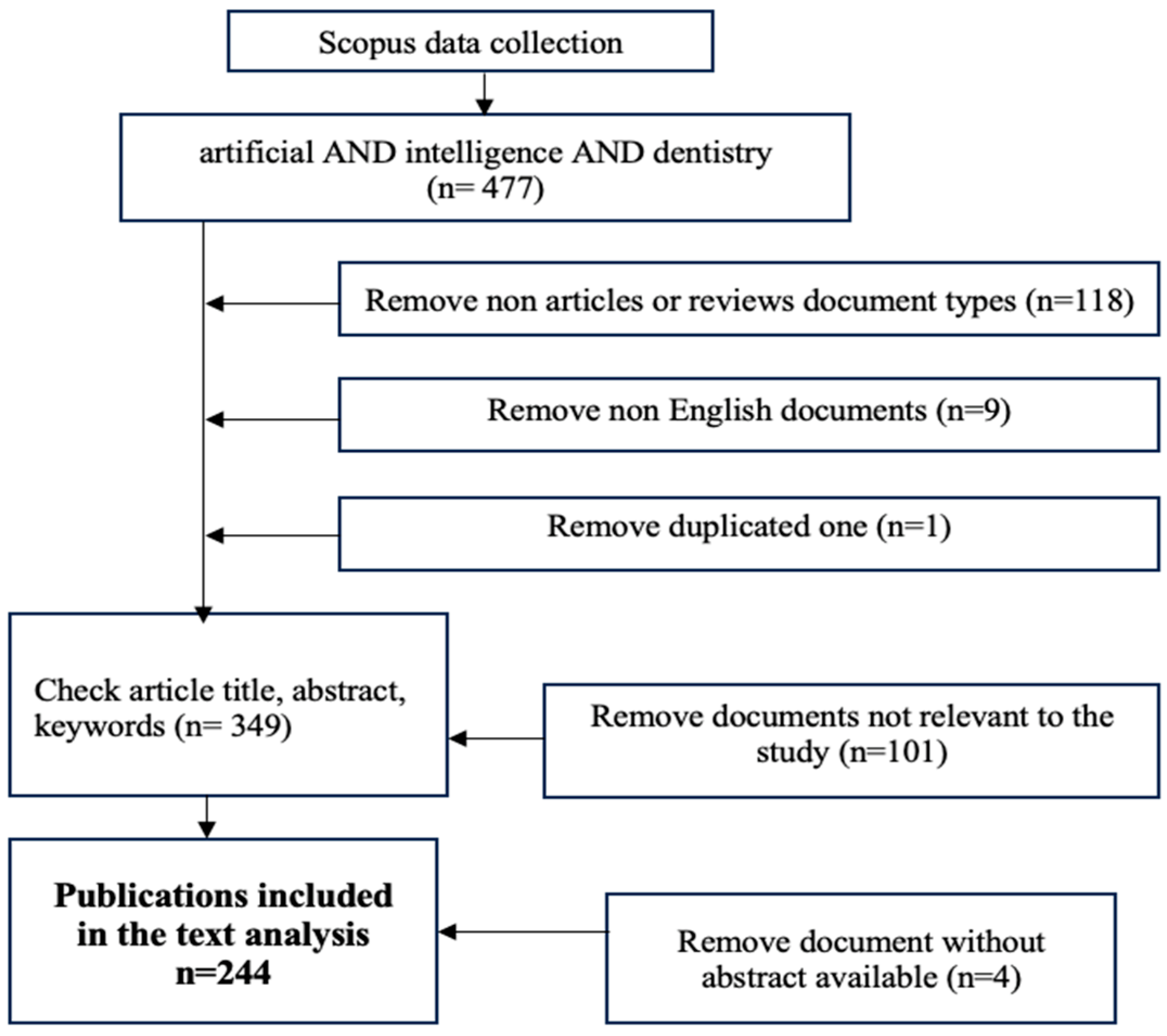

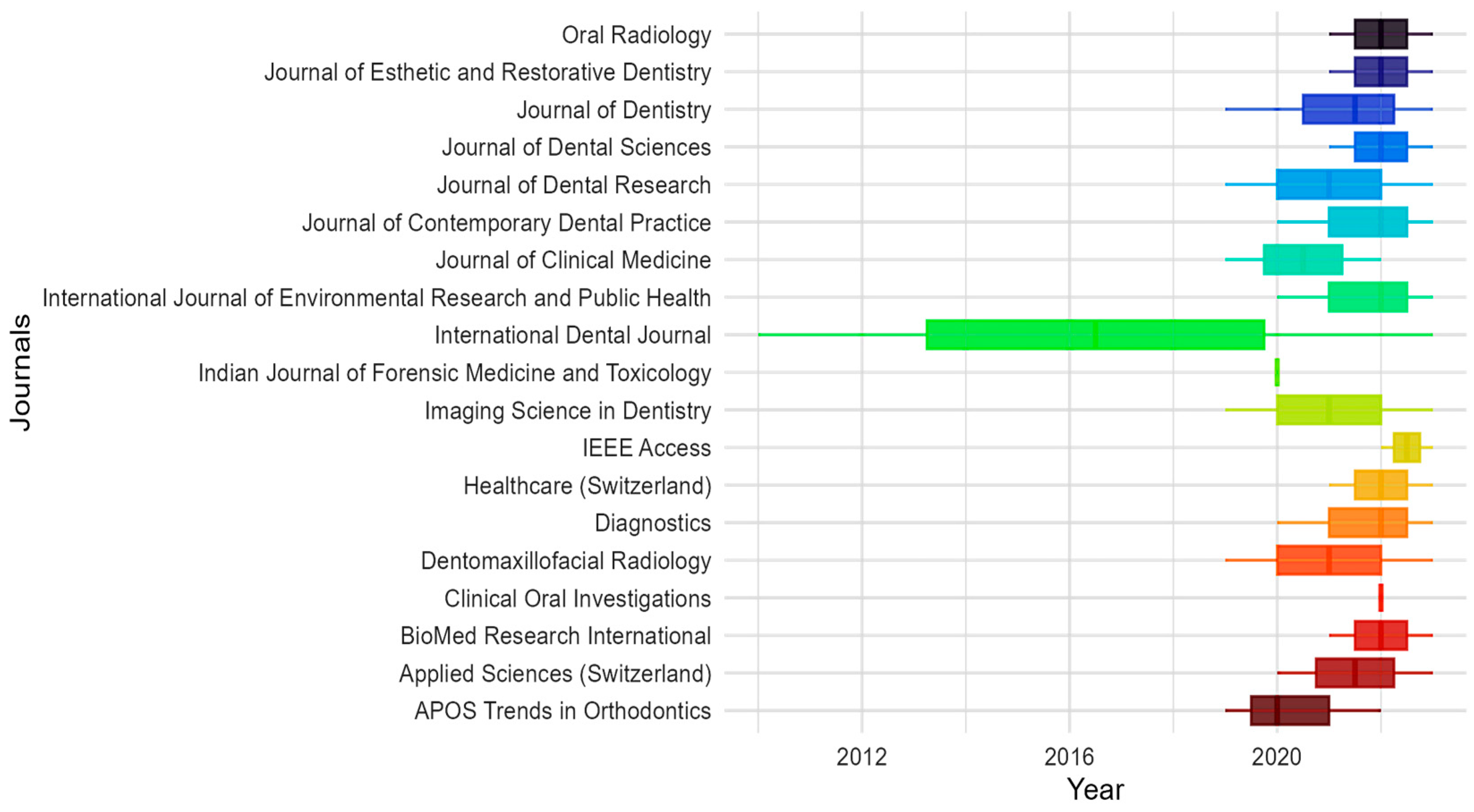
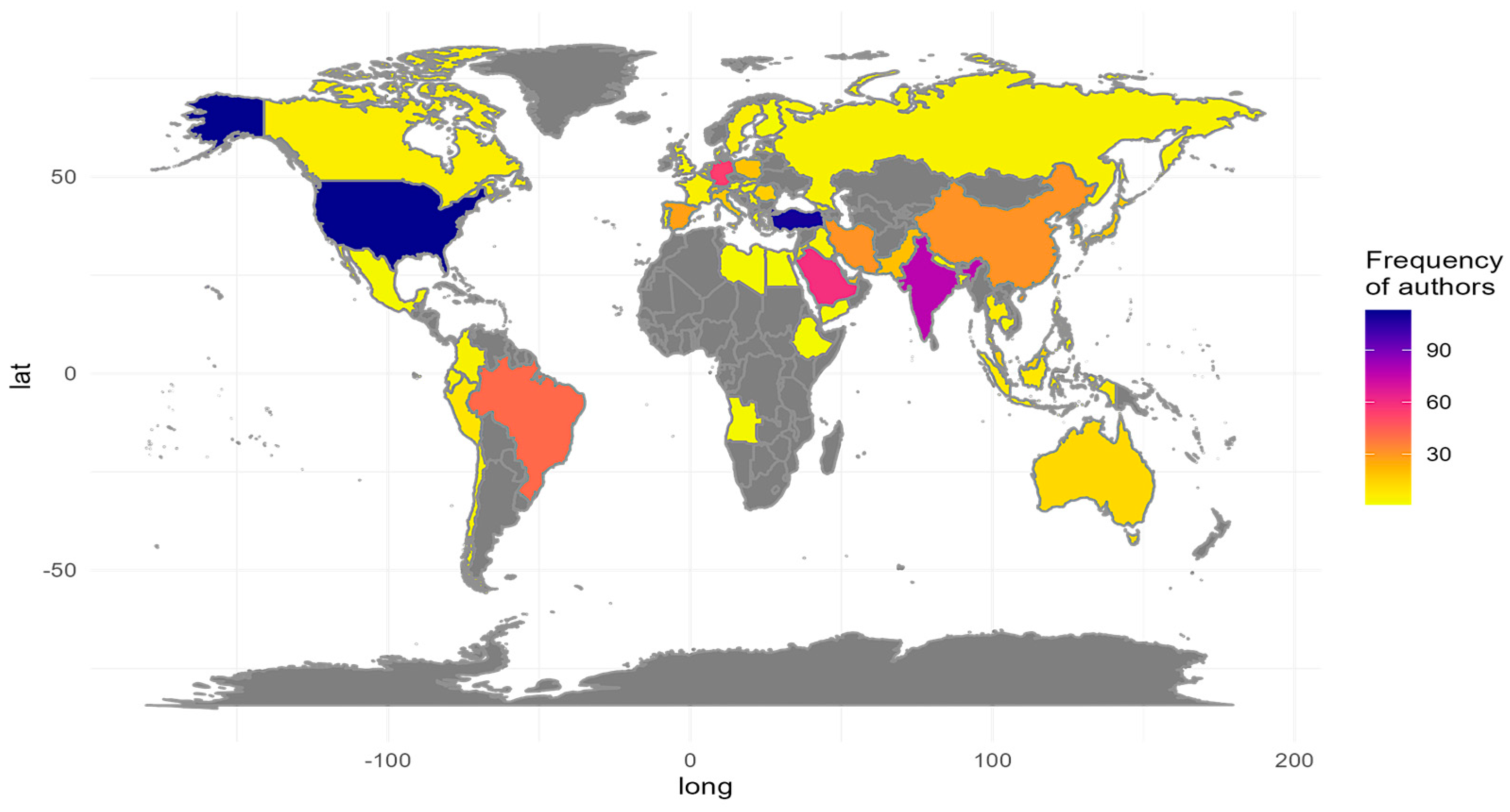


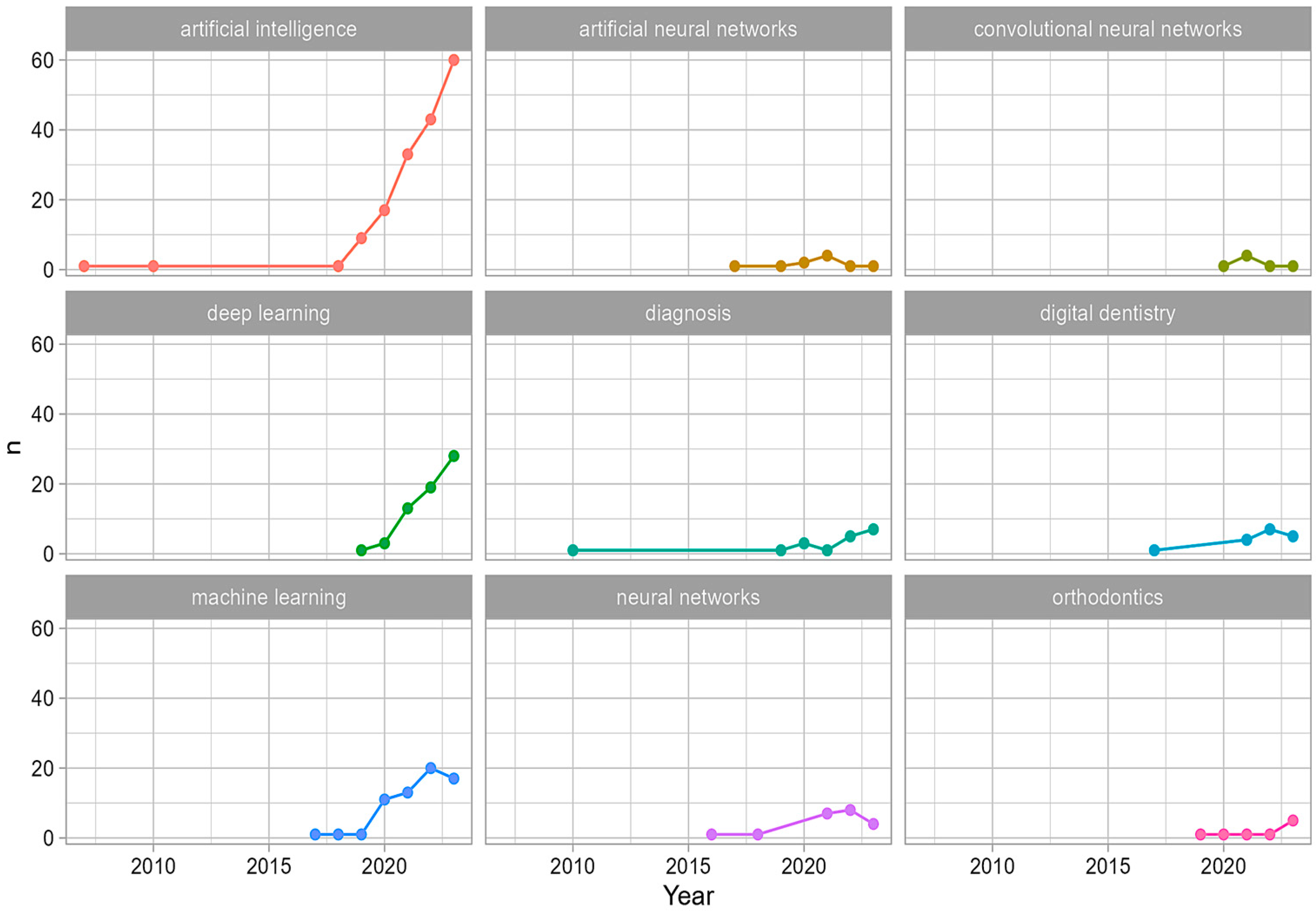
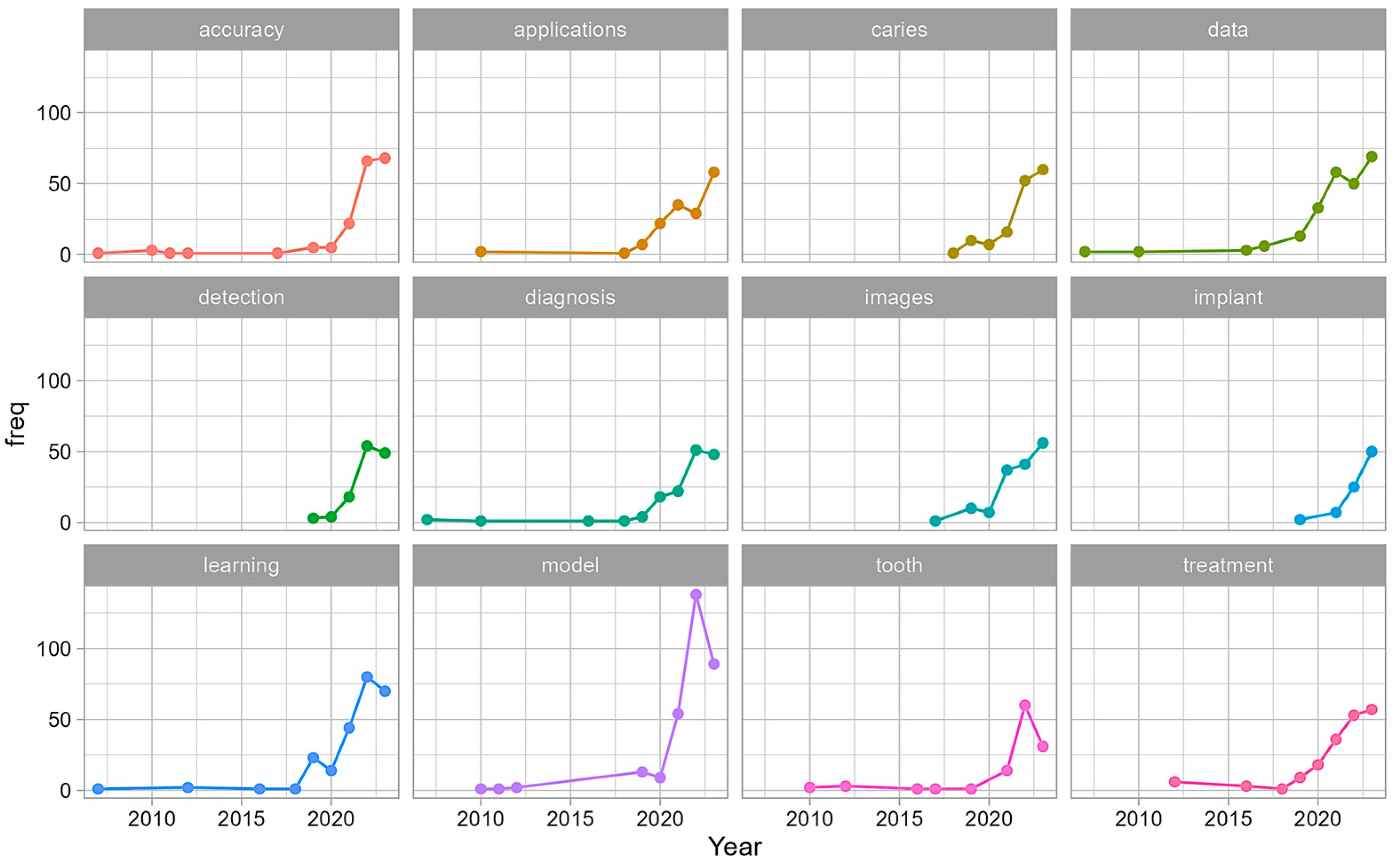
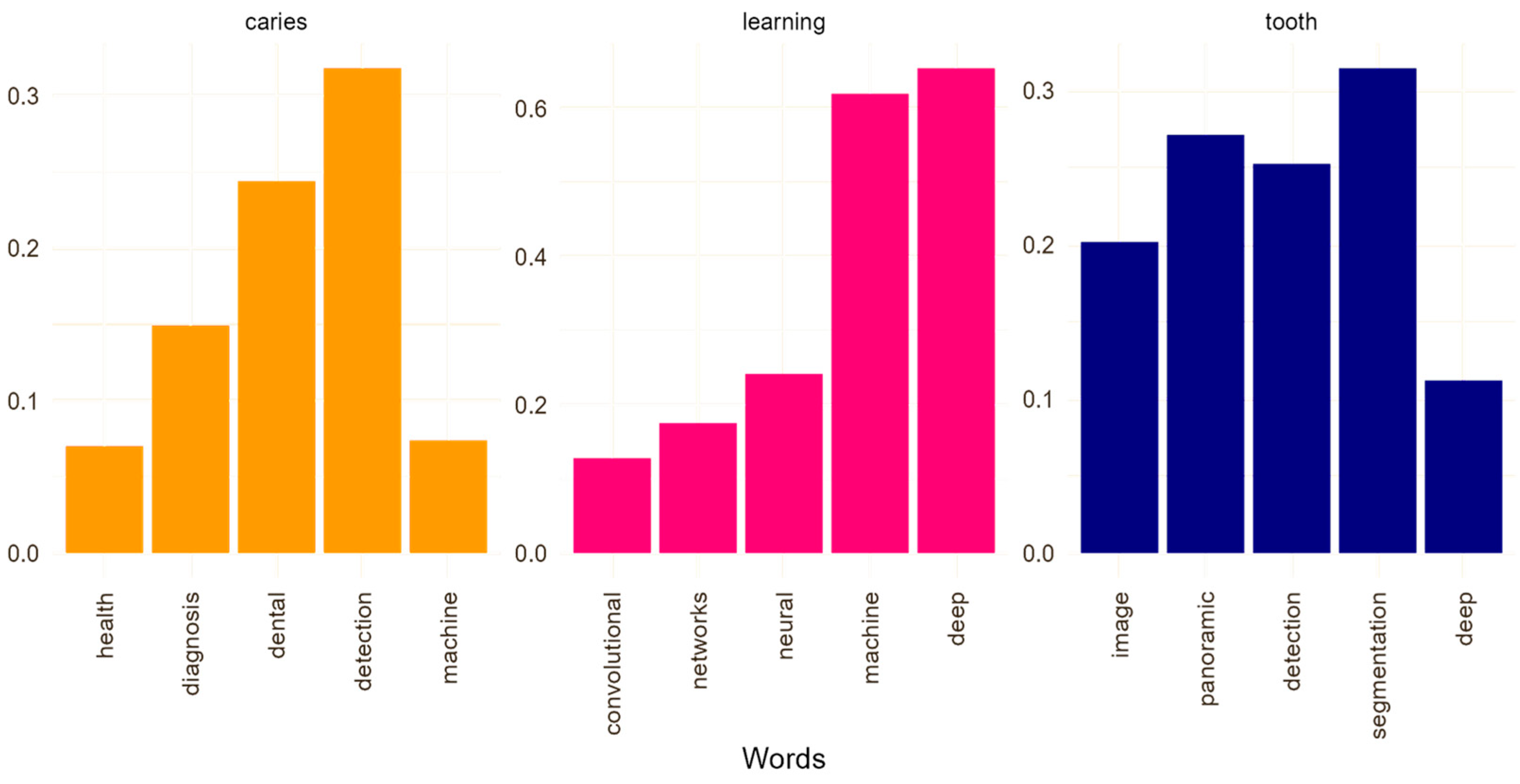
Disclaimer/Publisher’s Note: The statements, opinions and data contained in all publications are solely those of the individual author(s) and contributor(s) and not of MDPI and/or the editor(s). MDPI and/or the editor(s) disclaim responsibility for any injury to people or property resulting from any ideas, methods, instructions or products referred to in the content. |
© 2024 by the authors. Licensee MDPI, Basel, Switzerland. This article is an open access article distributed under the terms and conditions of the Creative Commons Attribution (CC BY) license (https://creativecommons.org/licenses/by/4.0/).
Share and Cite
Allani, H.; Santos, A.T.; Ribeiro-Vidal, H. Multidisciplinary Applications of AI in Dentistry: Bibliometric Review. Appl. Sci. 2024, 14, 7624. https://doi.org/10.3390/app14177624
Allani H, Santos AT, Ribeiro-Vidal H. Multidisciplinary Applications of AI in Dentistry: Bibliometric Review. Applied Sciences. 2024; 14(17):7624. https://doi.org/10.3390/app14177624
Chicago/Turabian StyleAllani, Hela, Ana Teresa Santos, and Honorato Ribeiro-Vidal. 2024. "Multidisciplinary Applications of AI in Dentistry: Bibliometric Review" Applied Sciences 14, no. 17: 7624. https://doi.org/10.3390/app14177624





